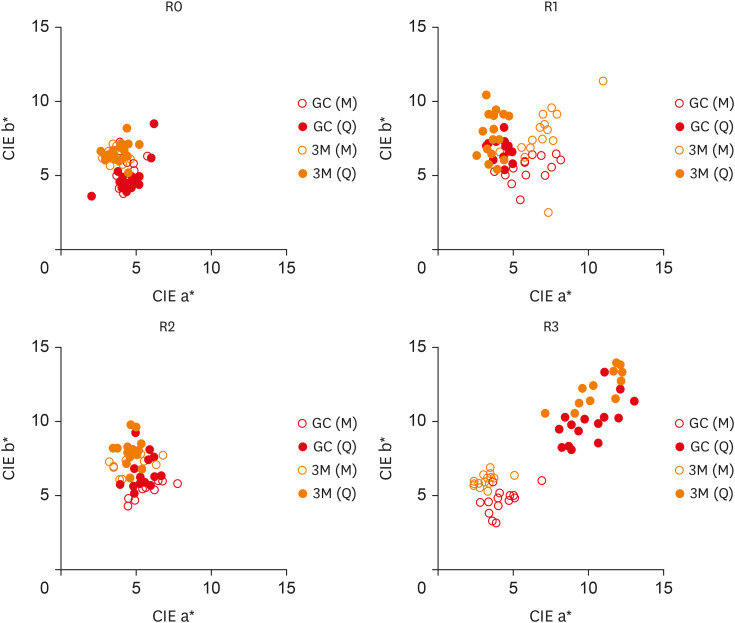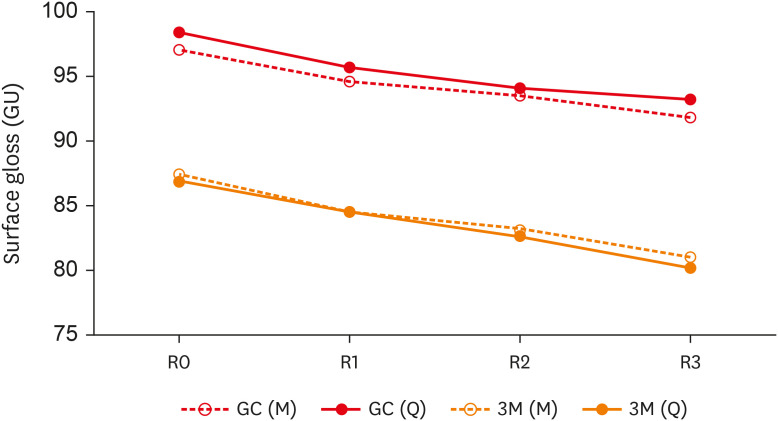Restor Dent Endod.
2022 Nov;47(4):e43. 10.5395/rde.2022.47.e43.
Surface gloss, gloss retention, and color stability of 2 nano-filled universal resin composites
- Affiliations
-
- 1Cátedra de Materiales Dentales, Facultad de Odontología, Universidad Nacional de Córdoba, Córdoba, Argentina
- 2Cátedra de Materiales Dentales, Facultad de Ciencias de la Salud, Universidad Católica de Córdoba, Córdoba, Argentina
- 3Restorative Dental Sciences Division, Faculty of Dentistry, University of Hong Kong, Hong Kong SAR, China
- KMID: 2548147
- DOI: http://doi.org/10.5395/rde.2022.47.e43
Abstract
Objectives
This study compared the surface gloss (SG), gloss retention (GR), and color stability (CS) of 2 universal resin composites after chemical (CA) and mechanical (MA) aging.
Materials and Methods
Twenty disc-shaped samples of G-ænial A´Chord (GC-Europe) and Filtek Universal (3M-ESPE) were polished with sequential abrasive papers. For CA, specimens were stored in 1 mL of 75% ethanol for 15 days at 37°C, and readings (SG, GR, and CS) were obtained at baseline and 5, 10, and 15 days. For MA, specimens were subjected to 10,750 simulated brushing cycles. SG and CS were evaluated after every 3,583 cycles. SG was measured with a glossmeter (geometrical configuration: 60°), and values were expressed in gloss units. Color was measured with a spectrophotometer using the CIE-L*a*b* color system. The Student’s t-test, 1-way analysis of variance, and Scheffé test were used for statistical analysis (α = 0.05).
Results
G-ænial presented significantly higher SG values than Filtek (p = 0.02), with GR reductions of 5.2% (CA) and 5.3% (MA) for G-ænial and 7.6% (CA) and 7.2% (MA) for Filtek. The aging protocol had no statistically significant effect on SG or GR (p = 0.25) from baseline to the final readings. G-ænial–MA presented the lowest color difference (∆E = 1.8), and G-ænial–CA and Filtek–CA had the largest changes (∆E = 8.6 and ∆E = 11.8, respectively).
Conclusion
G-ænial presented higher SG values and better CS. Both restorative materials demonstrated acceptable GR and CS. Aging protocols impacted these properties negatively.
Figure
Reference
-
1. Weston JF. Predictable nanohybrid composite systems and techniques for anterior and posterior direct restorations. Compend Contin Educ Dent. 2013; 34:8–12.2. Kumari RV, Nagaraj H, Siddaraju K, Poluri RK. Evaluation of the effect of surface polishing, oral beverages and food colorants on color stability and surface roughness of nanocomposite resins. J Int Oral Health. 2015; 7:63–70.3. Lainović T, Blažić L, Kukuruzović D, Vilotić M, Ivanišević A, Kakaš D. Effect of diamond paste finishing on surface topography and roughness of dental nanohybrid composites - AFM analysis. Procedia Eng. 2014; 69:945–951.
Article4. Aydın N, Topçu FT, Karaoğlanoğlu S, Oktay EA, Erdemir U. Effect of finishing and polishing systems on the surface roughness and color change of composite resins. J Clin Exp Dent. 2021; 13:e446–e454. PMID: 33981391.
Article5. Fugolin APP, Pfeifer CS. New resins for dental composites. J Dent Res. 2017; 96:1085–1091. PMID: 28732183.
Article6. Paravina RD, Ghinea R, Herrera LJ, Bona AD, Igiel C, Linninger M, Sakai M, Takahashi H, Tashkandi E, Perez MM. Color difference thresholds in dentistry. J Esthet Restor Dent. 2015; 27(Supplement 1):S1–S9. PMID: 25886208.
Article7. Guo G, Shi Q, Luo Y, Fan R, Zhou L, Qian Z, Yu J. Preparation and ageing-resistant properties of polyester composites modified with functional nanoscale additives. Nanoscale Res Lett. 2014; 9:215. PMID: 24872802.
Article8. Nair SR, Niranjan NT, Jayasheel A, Suryakanth DB. Comparative evaluation of colour stability and surface hardness of methacrylate based flowable and packable composite - in vitro study. J Clin Diagn Res. 2017; 11:ZC51–ZC54.9. Rocha RS, Oliveira AC, Caneppele TMF, Bresciani E. Effect of artificial aging protocols on surface gloss of resin composites. Int J Dent. 2017; 2017:3483171. PMID: 28611843.
Article10. Jain V, Platt JA, Moore K, Spohr AM, Borges GA. Color stability, gloss, and surface roughness of indirect composite resins. J Oral Sci. 2013; 55:9–15. PMID: 23485595.
Article11. Yadav RD, Raisingani D, Jindal D, Mathur R. A comparative analysis of different finishing and polishing devices on nanofilled, microfilled, and hybrid composite: a scanning electron microscopy and profilometric study. Int J Clin Pediatr Dent. 2016; 9:201–208. PMID: 27843250.
Article12. AlJazairy YH, Mitwalli HA, AlMoajel NA. The effect of polishing systems on surface roughness of nanohybrid and microhybrid resin composites. Am J Dent. 2019; 32:47–52. PMID: 30834732.13. Soliman HAN, Elkholany NR, Hamama HH, El-Sharkawy FM, Mahmoud SH, Comisi JC. Effect of different polishing systems on the surface roughness and gloss of novel nanohybrid resin composites. Eur J Dent. 2021; 15:259–265. PMID: 33111284.
Article14. Gönülol N, Yilmaz F. The effects of finishing and polishing techniques on surface roughness and color stability of nanocomposites. J Dent. 2012; 40(Supplement 2):e64–e70.
Article15. Zhang L, Yu P, Wang XY. Surface roughness and gloss of polished nanofilled and nanohybrid resin composites. J Dent Sci. 2021; 16:1198–1203. PMID: 34484588.
Article16. Paravina RD, Pérez MM, Ghinea R. Acceptability and perceptibility thresholds in dentistry: a comprehensive review of clinical and research applications. J Esthet Restor Dent. 2019; 31:103–112. PMID: 30891913.
Article17. Rocha RS, Fagundes TC, Caneppele T, Bresciani E. Perceptibility and acceptability of surface gloss variations in dentistry. Oper Dent. 2020; 45:134–142. PMID: 31373888.
Article18. Schmidt C, Ilie N. The effect of aging on the mechanical properties of nanohybrid composites based on new monomer formulations. Clin Oral Investig. 2013; 17:251–257.
Article19. Drummond JL. Degradation, fatigue, and failure of resin dental composite materials. J Dent Res. 2008; 87:710–719. PMID: 18650540.
Article20. Boaro LC, Gonçalves F, Guimarães TC, Ferracane JL, Pfeifer CS, Braga RR. Sorption, solubility, shrinkage and mechanical properties of “low-shrinkage” commercial resin composites. Dent Mater. 2013; 29:398–404. PMID: 23414910.
Article21. Gul P, Karatas O, Alp HH, Cam IB, Ozakar-Ilday N. Monomer release from nanohybrid composites after bleaching. J Oral Sci. 2019; 61:351–357. PMID: 31217386.
Article22. Thaliyadeth LB, Chakravarthy D, Neelamurthy PS, Selvapandiane V, Jayadevan A, Dimple N. Comparative evaluation of color stability of nanohybrid direct and indirect resin-based composites to Indian spices: an in vitro study. J Contemp Dent Pract. 2019; 20:1071–1076. PMID: 31797832.
Article23. Sideridou ID, Karabela MM, Bikiaris DN. Aging studies of light cured dimethacrylate-based dental resins and a resin composite in water or ethanol/water. Dent Mater. 2007; 23:1142–1149. PMID: 17118438.
Article24. Schneider LF, Moraes RR, Cavalcante LM, Sinhoreti MA, Correr-Sobrinho L, Consani S. Cross-link density evaluation through softening tests: effect of ethanol concentration. Dent Mater. 2008; 24:199–203. PMID: 17544496.
Article25. Salgado VE, Cavalcante LM, Silikas N, Schneider LF. The influence of nanoscale inorganic content over optical and surface properties of model composites. J Dent. 2013; 41(Supplement 5):e45–e53. PMID: 23748102.
Article26. Giacomelli L, Derchi G, Frustaci A, Orlando B, Covani U, Barone A, De Santis D, Chiappelli F. Surface roughness of commercial composites after different polishing protocols: an analysis with atomic force microscopy. Open Dent J. 2010; 4:191–194. PMID: 21228920.
Article
- Full Text Links
- Actions
-
Cited
- CITED
-
- Close
- Share
- Similar articles
-
- Comparison of the Surface Properties and Color Stability of Various Aesthetic Restorative Materials Treated with In-Office Tooth Bleaching
- The color stability of aesthetic restorative materials resulting from accelerated aging
- Surface treatment, liquid, and aging effects on color and surface properties of monolithic ceramics
- Color Stability of Bulk-Fill Resin Composites after Immersion in Different Media
- A comparative study on color and dimensional stability of esthetic indirect dental materials




